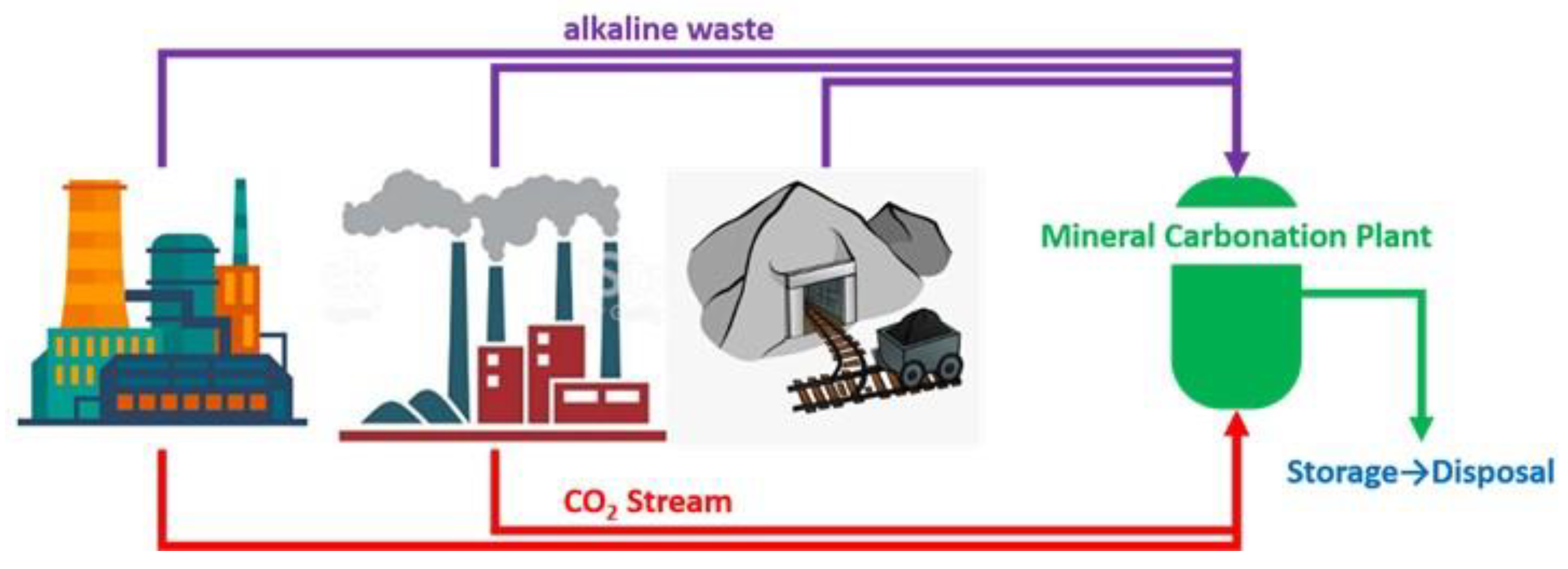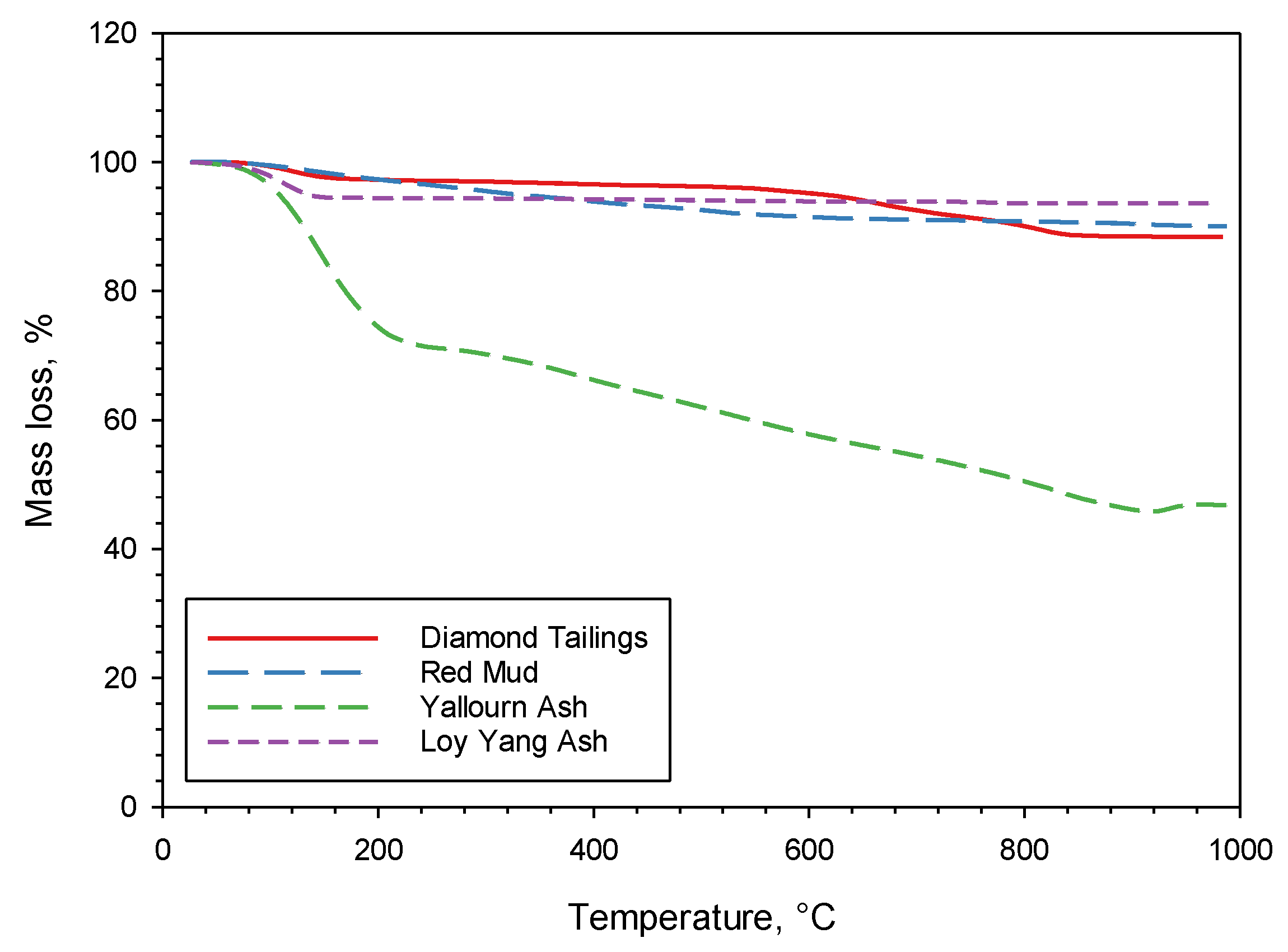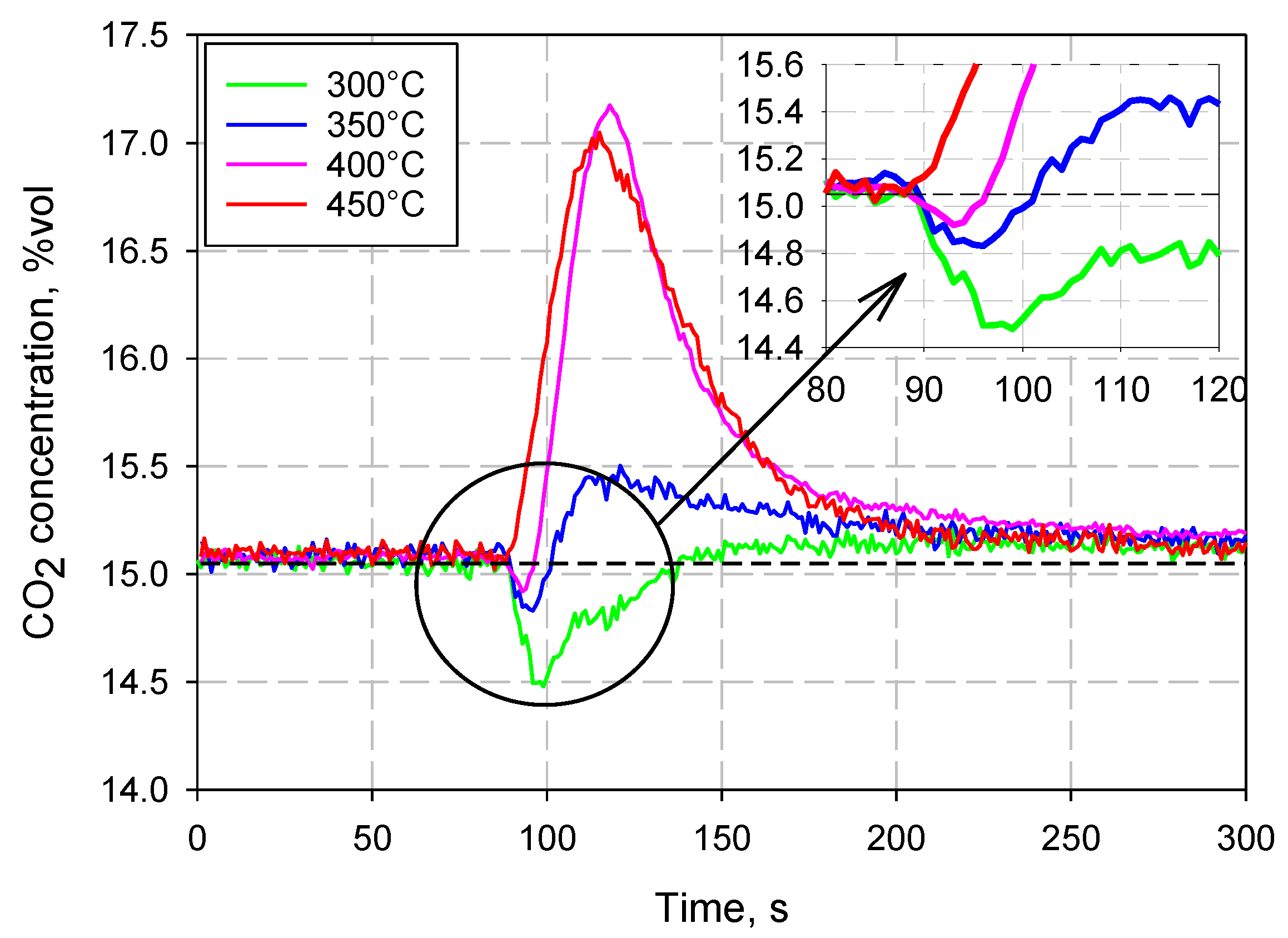Direct Dry Carbonation of Mining and Industrial Wastes in a Fluidized Bed for Offsetting Carbon Emissions
Abstract
:1. Introduction
2. Materials and Methods
2.1. Materials
2.2. Thermogravimetric (TG) Characterization
2.3. Carbonation Test Apparatus
2.4. Carbonation Test Procedure
- = mass flow rate of CO2 entering the reactor;
- = mass flow rate of CO2 leaving the reactor, expressed as a function of time t;
- = mass of carbon dioxide captured;
- = mass of the sorbent initially used for the test.
2.5. XRD Analysis
3. Results and Discussion
4. Conclusions
Author Contributions
Funding
Data Availability Statement
Acknowledgments
Conflicts of Interest
References
- Bobicki, E.R.; Liu, Q.; Xu, Z.; Zeng, H. Carbon capture and storage using alkaline industrial wastes. Prog. Energy Combust. Sci. 2012, 38, 302–320. [Google Scholar] [CrossRef]
- Wang, F.; Dreisinger, D.B.; Jarvis, M.; Hitchins, T. The technology of CO2 sequestration by mineral carbonation: Current status and future prospects. Can. Met. Q. 2018, 57, 46–58. [Google Scholar] [CrossRef] [Green Version]
- Huijgen, W.J.J.; Comans, R.N.J. Carbon Dioxide Sequestration by Mineral Carbonation; Literature Review ECN-C-03-016; Energy Research Centre: Wageningen, The Netherlands, 2003. [Google Scholar]
- Lackner, K.S.; Wendt, C.H.; Butt, D.P.; Joyce, E.L., Jr.; Sharp, D.H. Carbon dioxide disposal in carbonate minerals. Energy 1995, 20, 1153–1170. [Google Scholar] [CrossRef]
- Doucet, F.J. Scoping Study on CO2 Mineralization Technologies; Contract report No CGS-2011-007; Council for Geoscience: Pretoria, South Africa, 2011. [Google Scholar]
- Huijgen, W.J.J.; Witkamp, G.-J.; Comans, R.N.J. Mineral CO2 Sequestration by Steel Slag Carbonation. Environ. Sci. Technol. 2005, 39, 9676–9682. [Google Scholar] [CrossRef] [PubMed]
- Goldberg, P.; Chen, Z.-Y.; O’Connor, W.; Walters, R.; Ziock, H. CO2 mineral sequestration studies in the US. In Proceedings of the First National Conference on Carbon Sequestration, Washington, DC, USA, 14–17 May 2001. [Google Scholar]
- Sanna, A.; Uibu, M.; Caramanna, G.; Kuusik, R.; Maroto-Valer, M.M. A review of mineral carbonation technologies to sequester CO2. Chem. Soc. Rev. 2014, 43, 8049–8080. [Google Scholar] [CrossRef] [PubMed] [Green Version]
- Gerdemann, S.J.; O’Connor, W.K.; Dahlin, D.C.; Penner, L.R.; Rush, H. Ex situ aqueous mineral carbonation. Environ. Sci. Technol. 2007, 41, 2587–2593. [Google Scholar] [CrossRef] [PubMed]
- Su, T.-H.; Yang, H.-J.; Shau, Y.-H.; Takazawa, E.; Lee, Y.-C. CO2 sequestration utilizing basic-oxygen furnace slag: Controlling factors, reaction mechanisms and V–Cr concerns. J. Environ. Sci. 2016, 41, 99–111. [Google Scholar] [CrossRef] [PubMed]
- Polettini, A.; Pomi, R.; Stramazzo, A. Carbon sequestration through accelerated carbonation of BOF slag: Influence of particle size characteristics. Chem. Eng. J. 2016, 298, 26–35. [Google Scholar] [CrossRef]
- Dananjayan, R.R.T.; Kandasamy, P.; Andimuthu, R. Direct mineral carbonation of coal fly ash for CO2 sequestration. J. Clean. Prod. 2016, 112, 4173–4182. [Google Scholar] [CrossRef]
- Mayoral, M.C.; Andrés, J.M.; Gimeno, M. Optimization of mineral carbonation process for CO2 sequestration by lime-rich coal ashes. Fuel 2013, 106, 448–454. [Google Scholar] [CrossRef]
- Hosseini, T.; Haque, N.; Selomulya, C.; Zhang, L. Mineral carbonation of Victorian brown coal fly ash using regenerative ammonium chloride–Process simulation and techno-economic analysis. Appl. Energy 2016, 175, 54–68. [Google Scholar] [CrossRef]
- Nyambura, M.G.; Mugera, G.W.; Felicia, P.L.; Gathura, N.P. Carbonation of brine impacted fractionated coal fly ash: Implications for CO2 sequestration. J. Environ. Manag. 2011, 92, 655–664. [Google Scholar] [CrossRef] [PubMed]
- Han, S.-J.; Im, H.J.; Wee, J.-H. Leaching and indirect mineral carbonation performance of coal fly ash-water solution system. Appl. Energy 2015, 142, 274–282. [Google Scholar] [CrossRef]
- Reynolds, B.; Reddy, K.J.; Argyle, M.D. Field Application of Accelerated Mineral Carbonation. Minerals 2014, 4, 191–207. [Google Scholar] [CrossRef] [Green Version]
- Kasina, M.; Kowalski, P.R.; Michalik, M. Mineral carbonation of metallurgical slags. Minerals 2015, 45, 27–45. [Google Scholar] [CrossRef] [Green Version]
- Santos, R.M.; François, D.; Mertens, G.; Elsen, J.; Van Gerven, T. Ultrasound-intensified mineral carbonation. Appl. Therm. Eng. 2013, 57, 154–163. [Google Scholar] [CrossRef] [Green Version]
- Kwak, J.H.; Hu, J.Z.; Turcu, R.V.; Rosso, K.M.; Ilton, E.S.; Wang, C.; Sears, J.A.; Engelhard, M.H.; Felmy, A.R.; Hoyt, D.W. The role of H2O in the carbonation of forsterite in supercritical CO2. Int. J. Greenh. Gas Control 2011, 5, 1081–1092. [Google Scholar] [CrossRef]
- Kwak, J.H.; Hu, J.Z.; Hoyt, D.W.; Sears, J.A.; Wang, C.; Rosso, K.M.; Felmy, A.R. Metal Carbonation of Forsterite in Supercritical CO2 and H2O Using Solid State 29Si, 13C NMR Spectroscopy. J. Phys. Chem. C 2010, 114, 4126–4134. [Google Scholar] [CrossRef]
- Eloneva, S.; Said, A.; Fogelholm, C.-J.; Zevenhoven, R. Preliminary assessment of a method utilizing carbon dioxide and steelmaking slags to produce precipitated calcium carbonate. Appl. Energy 2012, 90, 329–334. [Google Scholar] [CrossRef]
- Chakravarthy, C.; Chalouati, S.; Chai, Y.E.; Fantucci, H.; Santos, R.M. Valorization of Kimberlite Tailings by Carbon Capture and Utilization (CCU) Method. Minerals 2020, 10, 611. [Google Scholar] [CrossRef]
- Choo, T.K.; Song, Y.; Zhang, L.; Selomulya, C.; Zhang, L. Mechanisms Underpinning the Mobilization of Iron and Magnesium Cations from Victorian Brown Coal Fly Ash. Energy Fuels 2014, 28, 4051–4061. [Google Scholar] [CrossRef]
- Xu, T.; Bhattacharya, S. Mineral Transformation and Morphological Change during Pyrolysis and Gasification of Victorian Brown Coals in an Entrained Flow Reactor. Energy Fuels 2019, 33, 6134–6147. [Google Scholar] [CrossRef]





| Component | Diamond Tailings (DT) | Red Mud (RM) | Yallourn Coal Ash (YA) | Loy Yang Coal Ash (LYA) |
|---|---|---|---|---|
| LOI | 9.00 | 9.36 | 34.45 | 0.01 |
| Al2O3 | 5.09 | 21.11 | 3.42 | 14.16 |
| BaO | 0.11 | <0.01 | 0.32 | <0.01 |
| CaO | 3.97 | 1.80 | 6.48 | 1.06 |
| Cr2O3 | 0.14 | 0.08 | <0.01 | 0.02 |
| Fe2O3 | 6.77 | 35.71 | 30.54 | 9.05 |
| K2O | 1.92 | 0.13 | 0.23 | 1.28 |
| MgO | 26.92 | 1.42 | 15.33 | 2.34 |
| MnO | 0.10 | 0.06 | 0.33 | <0.01 |
| Na2O | 0.60 | 9.55 | 0.57 | 2.23 |
| P2O5 | 0.22 | 0.11 | 0.02 | 0.12 |
| SO3 | 0.91 | 0.67 | 2.35 | 3.62 |
| SiO2 | 43.74 | 14.24 | 5.75 | 64.30 |
| SrO | 0.05 | <0.01 | 0.05 | <0.01 |
| TiO2 | 0.44 | 5.75 | 0.13 | 1.81 |
| Sample | Major Minerals Identified | Minor Minerals Identified |
|---|---|---|
| Diamond Tailings As received | Magnesium Silicate Hydroxide (antigorite), Magnesium Iron Silicate Oxide (forsterite), Potassium Iron Magnesium Aluminum Silicate Hydroxide (phlogopite), Silicon Oxide (quartz), Calcium Carbonate (calcite) | Iron Silicate (ferrosilite), Iron Magnesium Silicate (enstatite) |
| Diamond Tailings Tested | Magnesium Silicate (chrysotile), Magnesium Iron Silicate Oxide (forsterite), Potassium Iron Magnesium Aluminum Silicate (phlogopite), Potassium Magnesium Aluminum Oxide Silicate (biotite), Iron Oxide (hematite), Calcium Carbonate (calcite), Silicon Oxide (quartz) | Magnesium Aluminum Silicate (cordierite), Magnesium Iron Aluminum Silicate (lizardite), Potassium Aluminum Silicate (microcline), Calcium Aluminum Silicate (anorthite) |
| Red Mud As received | Iron Oxide (hematite), Sodium Aluminum Silicate Hydrate (sodalite), Titanium Oxide (anatase) | Calcium Magnesium Iron Oxide Silicate (actinolite), Aluminum Oxide Hydroxide (boehmite) |
| Red Mud Tested | Iron Oxide (hematite), Sodium Aluminum Silicate Carbonate (cancrinite), Titanium Oxide (anatase) | Aluminum Silicon Oxide (mullite), Calcium Magnesium Carbonate (dolomite), Sodium Iron Silicate (aegirine), Silicon Oxide (quartz) |
| Yallourn ash As received | Iron Oxide (magnetite), Magnesium Iron Oxide (magnesioferrite), Silicon Oxide (quartz), | Calcium Aluminum Hydroxide Carbonate (hydrocalumite), Calcium Iron Silicate (hedenbergite) |
| Yallourn ash Tested | Iron Oxide (magnetite), Magnesium Iron Oxide (magnesioferrite), Silicon Oxide (quartz), | Calcium Carbonate (calcite) |
| Loy Yang ash As received | Silicon Oxide (quartz), Iron Oxide (hematite), Calcium Aluminum Silicate hydrate (gismondine) | Sodium Aluminum Sulfate Hydrate (sodium alum), Magnesium Sulfate Hydroxide (caminite), Titanium Oxide (rutile) |
| Loy Yang ash Tested | Silicon Oxide (quartz), Iron Oxide (hematite), | Calcium Magnesium Iron Silicate (diopside), Calcium Sodium Aluminum Silicate (anorthite), Calcium Carbonate (calcite), Calcium Magnesium Carbonate (dolomite), Titanium Oxide (rutile) |
Publisher’s Note: MDPI stays neutral with regard to jurisdictional claims in published maps and institutional affiliations. |
© 2022 by the authors. Licensee MDPI, Basel, Switzerland. This article is an open access article distributed under the terms and conditions of the Creative Commons Attribution (CC BY) license (https://creativecommons.org/licenses/by/4.0/).
Share and Cite
Coppola, A.; Scala, F.; Azadi, M. Direct Dry Carbonation of Mining and Industrial Wastes in a Fluidized Bed for Offsetting Carbon Emissions. Processes 2022, 10, 582. https://doi.org/10.3390/pr10030582
Coppola A, Scala F, Azadi M. Direct Dry Carbonation of Mining and Industrial Wastes in a Fluidized Bed for Offsetting Carbon Emissions. Processes. 2022; 10(3):582. https://doi.org/10.3390/pr10030582
Chicago/Turabian StyleCoppola, Antonio, Fabrizio Scala, and Mehdi Azadi. 2022. "Direct Dry Carbonation of Mining and Industrial Wastes in a Fluidized Bed for Offsetting Carbon Emissions" Processes 10, no. 3: 582. https://doi.org/10.3390/pr10030582
APA StyleCoppola, A., Scala, F., & Azadi, M. (2022). Direct Dry Carbonation of Mining and Industrial Wastes in a Fluidized Bed for Offsetting Carbon Emissions. Processes, 10(3), 582. https://doi.org/10.3390/pr10030582








